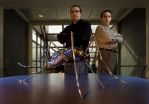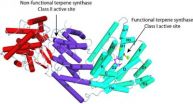(Press-News.org) A team of researchers led by the University of Colorado Boulder has used NASA's Hubble Space Telescope to uncover a cluster of galaxies in the initial stages of construction -- the most distant such grouping ever observed in the early universe.
In a random sky survey made in near-infrared light, Hubble spied five small galaxies clustered together 13.1 billion light-years away. They are among the brightest galaxies at that epoch and very young, living just 600 million years after the universe's birth in the Big Bang. One light-year is about 6 trillion miles.
Galaxy clusters are the largest structures in the universe, comprising hundreds to thousands of galaxies bound together by gravity. The developing cluster, or protocluster, presumably will grow into one of today's massive galactic "cities" comparable to the nearby Virgo cluster, a collection of more than 2,000 galaxies.
"These galaxies formed during the earliest stages of galaxy assembly, when galaxies had just started to cluster together," says the study's leader, Michele Trenti, a research associate at CU-Boulder's Center for Astrophysics and Space Astronomy and a newly appointed scientist at the Institute of Astronomy at the University of Cambridge in the United Kingdom. "The result confirms our theoretical understanding of the buildup of galaxy clusters. And Hubble is just powerful enough to find the first examples of them at this distance."
Trenti will present his results Jan. 10 at the American Astronomical Society meeting in Austin, Texas. The study will appear in the Feb. 10 issue of the Astrophysical Journal.
Most galaxies in the universe live in groups and clusters, and astronomers have probed many mature "galactic cities" in detail as far as 11 billion light-years away. But finding clusters in the early phases of construction has been challenging because they are rare, dim and widely scattered across the sky.
"Records are always exciting, and this is the earliest and the most distant developing galaxy cluster that has ever been seen," said CU-Boulder Professor Michael Shull of the astrophysical and planetary sciences department, a member of the observing team. "We have seen individual galaxies this old and far away, but we have not seen groups of them in the construction process before."
Last year, a group of astronomers uncovered one distant developing cluster. Led by Peter L. Capak of NASA's Spitzer Science Center at the California Institute of Technology in Pasadena, the astronomers discovered a galactic grouping 12.6 billion light-years away with a variety of telescopes, including Hubble. Spectroscopic observations were made with the W.M. Keck Observatory in Hawaii to confirm the cluster's distance by measuring how much its light has been stretched by the expansion of space.
Trenti's team used the sharp-eyed Wide Field Camera 3 to hunt for the elusive catch. "We need to look in many different areas because the odds of finding something this rare are very small," Trenti said. "It's like playing a game of Battleship: The search is hit and miss. Typically a region has nothing, but if we hit the right spot we can find multiple galaxies."
Because these distant, fledgling clusters are so dim, the team hunted for the systems' brightest galaxies. These bright lights act as billboards, advertising cluster construction zones, according to the team. Galaxies at early epochs don't live alone. From simulations, the astronomers expect galaxies to be clustered together.
Because brightness correlates with mass, the most luminous galaxies pinpoint the location of developing clusters. These powerful light beacons live in deep wells of dark matter, which form the underlying structure in which galaxy clusters form, Trenti said. The team expects many fainter galaxies that were not seen in these observations to inhabit the same neighborhood.
The five bright galaxies spotted by Hubble are about one-half to one-tenth the size of our Milky Way, yet are comparable in brightness. The galaxies are bright and massive because they are being fed lots of gas through mergers with other galaxies, Trenti said. The team's simulations show that the galaxies will eventually merge and form the brightest central galaxy in the cluster, a giant elliptical similar to the Virgo Cluster's M87.
The observations demonstrate the progressive buildup of galaxies and provide further support for the hierarchical model of galaxy assembly, in which small objects accrete mass, or merge, to form bigger objects over a smooth and steady but dramatic process of collision and agglomeration. Astronomers have likened the process to streams merging into tributaries, then into rivers and to a bay.
Hubble looked in near-infrared light because ultraviolet and visible light from distant objects have been stretched into near-infrared wavelengths by the expansion of space in these extremely distant galaxies. The observations are part of the Brightest of Reionizing Galaxies or BoRG survey, which is using Hubble's Wide Field Camera 3 to search for the brightest galaxies around 13 billion years ago, when light from the first stars burned off a fog of cold hydrogen in a process called reionization.
The team estimated the distance to the newly spied galaxies based on their colors, but the astronomers plan to follow up with spectroscopic observations to confirm their distance.
Without spectroscopic observations, it's not clear whether the observed galaxies are gravitationally bound yet. The average distance between them is likely comparable to that of the galaxies in the Local Group, consisting of two large spiral galaxies, the Milky Way and Andromeda, and a few dozen small dwarf galaxies.
These observations are pushing Hubble to the limit of its ability. This region, however, will be prime country for future telescopes such as NASA's James Webb Space Telescope, an infrared observatory scheduled to launch later this decade. Webb will see farther into the infrared, allowing it to hunt for even earlier stages of galaxy assembly within 300 million years of the Big Bang.
Shull, also a faculty member at CU-Boulder's Center for Astrophysics and Space Astronomy, said the research team will receive an additional 260 orbits of observation time on Hubble to continue the search for more of the fledgling galaxy clusters as part of the BoRG survey. "There is high interest right now in learning if Earth is unique in the universe in its ability to host life," he said. "Similarly, we are interested to see if these ancient, forming galaxy clusters we have identified are unique, or if there are others out there. I expect that we may find a few more."
INFORMATION:
The Hubble Space Telescope is a project of international cooperation between NASA and the European Space Agency. NASA's Goddard Space Flight Center manages the telescope. The Space Telescope Science Institute, or STScI, conducts Hubble science operations. STScI is operated for NASA by the Association of Universities for Research in Astronomy Inc., in Washington, D.C.
For more information on the galaxies visit the news center at http://hubblesite.org/. For more information on CU-Boulder's CASA visit http://casa.colorado.edu/.
Contact:
Michele Trenti
Michele.Trenti@colorado.edu
Michael Shull, 303-492-7827
Michael.Shull@colorado.edu
Ray Villard, STScI media relations, 410-338-4514
villard@stsci.edu
Jim Scott, CU-Boulder media relations, 303-492-3114
Jim.Scott@colorado.edu
University of Colorado-led study pinpoints farthest developing galaxy cluster ever found
Galaxy cluster construction zone is about 13.1 billion light-years away
2012-01-11
ELSE PRESS RELEASES FROM THIS DATE:
Alpharetta Chiropractic Increases Patient Knowledge Through Blog
2012-01-11
Dr. Matt DiDuro of Health Choice Chiropractic Center, Alpharetta chiropractic, further informs patients of valuable chiropractic health care topics via his new practice blog. Whether they are current patients, or simply searching for a chiropractor in Alpharetta and surrounding areas, Dr. DiDuro is excited to offer increased chiropractic knowledge through his practice blog.
"With the chiropractic industry advancing, we recognize the importance of keeping our patients and visitors up-to-date with all of the new and exciting things taking place at our practice. With ...
Backing out of the nanotunnel
2012-01-11
In the world of biomolecules such as proteins and the hereditary nucleic acids DNA and RNA, three-dimensional structure determines function. Analysis of the passage of such molecules through nanopores offers a relatively new, but highly promising, technique for obtaining information about their spatial conformations. However, interactions between the test molecules and the proteins used as pores have so far hindered quantitative analysis of the behavior of even simply structured molecules within nanopores. This problem must be solved before the technique can be routinely ...
Cosmetic Dentist in Alpharetta and Douglasville Maintains Three Practice Locations
2012-01-11
Dr. Timothy Byrd, dentist in Alpharetta, GA, of Byrd Dental Group is pleased to maintain three convenient office locations for easy access to dental health care for patients. Dr. Byrd invites patients to visit any of Byrd Dental Group's three locations for increased convenience and care.
All three offices strive to deliver quality dental care to informed patients in Woodstock, Douglasville and Alpharetta, GA areas. With three offices, patients can visit the location that is closest for them. Each office offers general and cosmetic dental care, including dental implants, ...
Researchers discover novel anti-viral immune pathway in the mosquito
2012-01-11
As mosquito-borne viral diseases like West Nile fever, dengue fever, and chikungunya fever spread rapidly around the globe, scientists at Virginia Tech are working to understand the mosquito's immune system and how the viral pathogens that cause these diseases are able to overcome it to be transmitted to human and animal hosts.
In nearly every part of the world, humans and animals experience high levels of morbidity and mortality after being bitten by mosquitoes infected with viruses. More than 100 different viruses transmitted by blood feeding arthropods like mosquitoes ...
SoftwareMedia.com's Software Giveaway Extravaganza - Free Software Giveaways All Month Long
2012-01-11
The only thing better than getting great software, is getting great software FREE! SoftwareMedia is hosting a month-long software giveaway extravaganza, wherein fans of their Facebook page or followers of their Twitter page have the chance to win free software. What's the catch, you ask? SoftwareMedia is expanding its Social Media efforts and is trying to get word out about its company. All you need to do is "Like" or "Follow" and you're one step closer to winning your own copy of Adobe Premiere Pro CS5, Flash Drives, and more!
SoftwareMedia has been ...
Reuse of municipal wastewater has potential to augment future drinking water supplies
2012-01-11
WASHINGTON — With recent advances in technology and design, treating municipal wastewater and reusing it for drinking water, irrigation, industry, and other applications could significantly increase the nation's total available water resources, particularly in coastal areas facing water shortages, says a new report from the National Research Council. It adds that the reuse of treated wastewater, also known as reclaimed water, to augment drinking water supplies has significant potential for helping meet future needs. Moreover, new analyses suggest that the possible health ...
Powerful New Book for National Mentoring Month
2012-01-11
Street gangs, drug addiction, child prostitution, homelessness, abuse and neglect are major concerns that affect millions of American youth. According to studies, half of the U.S. youth population (17.6 million kids) is considered "at-risk" of getting into trouble with the law, or "high-risk" and already in trouble.
Our kids need help.
January is National Mentoring Month. A study done by Public/Private Ventures in Philadelphia showed that children matched with mentors through Big Brothers Big Sisters were 46% less likely to begin using illegal ...
An apple a day isn't enough
2012-01-11
Montreal, January 10, 2012 — Adults from 30 to 60 years old, especially those from lower socioeconomic backgrounds, aren't consuming the daily recommended levels of fruits and vegetables. Quebecers, however, eat more of nature's produce than their fellow Canadians.
These are some of the findings of a new Concordia University study, published by Nutrition Journal, which sheds light on who reaches in their fridge crisper often enough to gain the health benefits of a balanced diet comprised of fruits and vegetables.
"People from the Atlantic to the western provinces ...
Disruption of biological clocks causes neurodegeneration, early death
2012-01-11
CORVALLIS, Ore. – New research at Oregon State University provides evidence for the first time that disruption of circadian rhythms – the biological "clocks" found in many animals – can clearly cause accelerated neurodegeneration, loss of motor function and premature death.
The study was published in Neurobiology of Disease and done by researchers at OSU and Oregon Health and Science University. Prior to this, it wasn't clear which came first - whether the disruption of biological clock mechanisms was the cause or the result of neurodegeneration.
"In these experiments, ...
Clearing a potential road block to bisabolane
2012-01-11
The recent discovery that bisabolane, a member of the terpene class of chemical compounds used in fragrances and flavorings, holds high promise as a biosynthetic alternative to D2 diesel fuel has generated keen interest in the green energy community and the trucking industry. Now a second team of researchers with the U.S Department of Energy (DOE)'s Joint BioEnergy Institute (JBEI) has determined the three-dimensional crystal structure of a protein that is key to boosting the microbial-based production of bisabolane as an advanced biofuel.
The JBEI research team, led ...
LAST 30 PRESS RELEASES:
School meals could unlock major gains for human and planetary health
Menopause hormone therapy does not appear to impact dementia risk
Signature patterns of brain activity may help predict recovery from traumatic brain injury
Dresden study uncovers new key mechanism in cancer cells
New species are now being discovered faster than ever before, study suggests
Cannabis-based products show limited short-term benefit for chronic pain, with increased risk of adverse effects
Cannabis products with more THC slightly reduce pain but cause more side effects
Clearing the brain of aging cells could aid epilepsy and reduce seizures
Brain injuries linked with potential risk of suicide, new study finds
New technique lights up where drugs go in the body, cell by cell
New study finds movement of fishing fleets can reveal shifts in marine ecosystems
Embargoed: New evidence points to potential treatment for vascular dementia
Study uncovers disrupted brain balance in alcohol dependence
Working in groups can help Republicans and Democrats agree on controversial content moderation online
Structural findings reveal how distinct GPCR ligands create different levels of activation
Anything-goes “anyons” may be at the root of surprising quantum experiments
UC review: Maximizing workplace opportunity for veterans
From generation to complex control: Metasurfaces make perfect vortex beams "within reach"
Thin-film lithium niobate-based detector: recent advances and perspectives
Exploring why some people may tend to persistently make bad choices
How cells balance their protein levels
Nirsevimab vs RSVpreF vaccine for RSV–related hospitalization in newborns
Effectiveness and impact of maternal RSV immunization and nirsevimab on medically attended RSV in US children
AI gives scientists a boost, but at the cost of too many mediocre papers
Next-generation vision model maps tree growth at sub-meter precision
Genes aren’t destiny for inherited blindness, study shows
MIT study: High-fat diets make liver cells more likely to become cancerous
Exposure to multiple fine particulate matter components and incident depression in the US Medicare population
Risk of burdensome health care spending over time in the US
Nirsevimab against hospitalizations and emergency department visits for lower respiratory tract infection in infants
[Press-News.org] University of Colorado-led study pinpoints farthest developing galaxy cluster ever foundGalaxy cluster construction zone is about 13.1 billion light-years away




